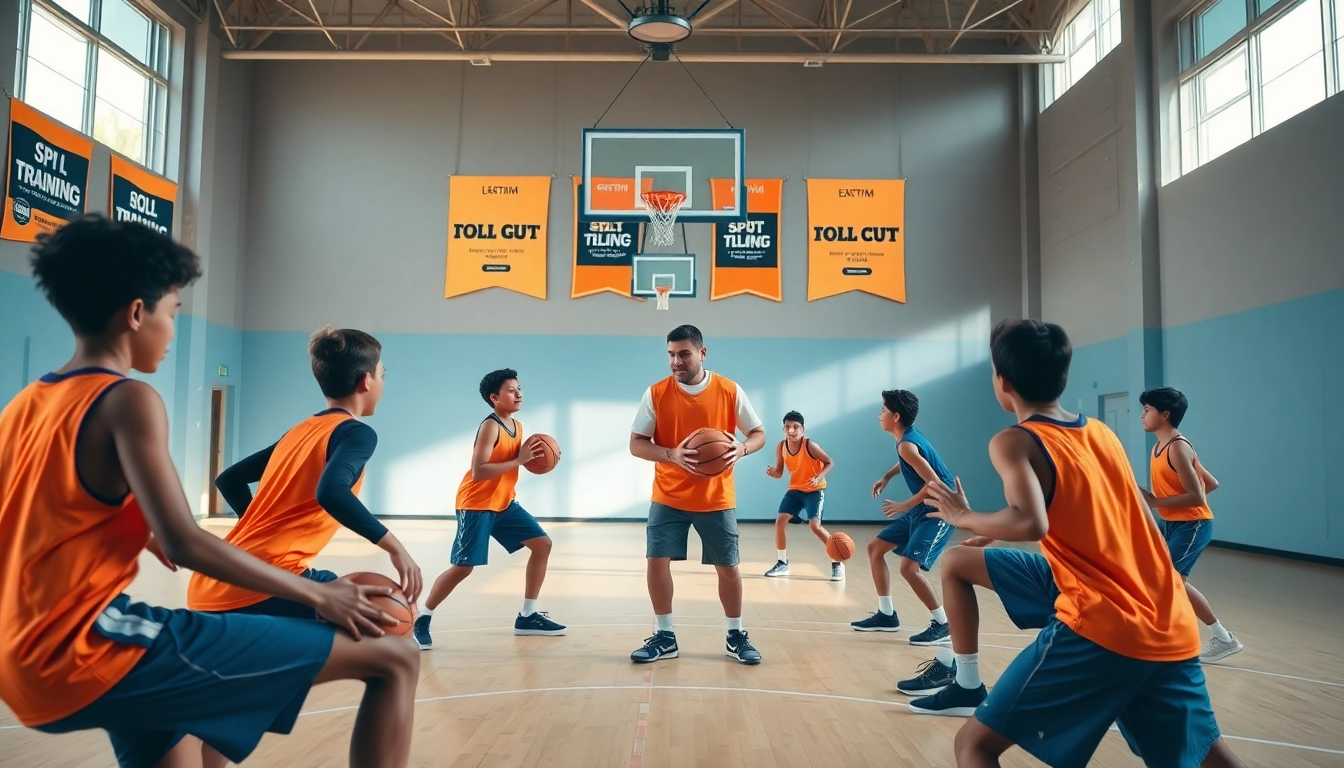
Understanding Basketball Training Programs
What Are Basketball Training Programs?
Basketball training programs are structured curricula designed to enhance a player’s skills, athleticism, and overall understanding of the game. These programs can vary widely, from basic skill drills for beginners to advanced strategies and techniques for seasoned players. They often include various components such as shooting drills, ball handling exercises, strength and conditioning training, and tactical gameplay analysis. Key characteristics of these programs include a systematic approach to skill development and the use of metrics to track progress. The best basketball training programs also adapt to the individual needs of participants, allowing for personalized training experiences that cater to specific skill levels and objectives.
The Benefits of Structured Training
Structured basketball training offers numerous advantages that can significantly improve a player’s performance on the court. Firstly, it instills discipline through regular practice and commitment. Players learn to set goals, track progress, and understand the importance of hard work and perseverance. Secondly, training programs often foster a sense of community, where players can engage with coaches and peers, sharing insights and encouraging one another. Importantly, these programs help in boosting players’ physical conditioning, agility, and strength—critical elements for success in basketball.
Additionally, structured training provides access to expert coaching. Professional trainers offer invaluable feedback, helping players to refine their skills and correct any technical deficiencies. This level of personalized attention is essential in maximizing a player’s potential, as well as fostering a deeper understanding of the game’s nuances.
Key Components of Effective Programs
An effective basketball training program is multifaceted, incorporating various elements that contribute to a player’s development. The key components include:
- Skill Development: Focused sessions on shooting, passing, dribbling, and defensive maneuvers.
- Physical Conditioning: Incorporation of strength, speed, and agility drills to enhance athletic performance.
- Tactical Understanding: Analysis of game scenarios and strategies to improve decision-making on the court.
- Mental Toughness: Strategies to build confidence and resilience during high-pressure situations.
These components combine to present a holistic approach to player development, ensuring that each athlete can maximize their abilities.
Identifying the Best Basketball Training Programs
Criteria for Evaluating Training Programs
When searching for the best basketball training programs, it’s crucial to evaluate them based on specific criteria. Here are some key factors to consider:
- Reputation: Research the program’s background, including the experience and qualifications of its coaches, as well as reviews from past participants.
- Curriculum Quality: Assess the structure of the program—does it provide a comprehensive skill set? Are training modules scientifically backed?
- Personalization: Determine whether the program offers tailored training to suit individual player needs.
- Accessibility: Consider the locations, schedule options, and format of the program (online vs. in-person).
- Results: Look for evidence of performance improvements among former participants; testimonials and case studies can provide insight.
Online vs. In-Person Training Options
Players today have the option of choosing between online and in-person training programs, each offering unique benefits.
Online Training has become increasingly popular due to its convenience. Players can access resources, video tutorials, and personalized feedback from coaches without geographical limitations. Programs like the Ball Handling Transformation Program by Jordan Lawley provide structured practices that players can engage in at their own pace.
In-Person Training, on the other hand, provides immediate feedback and hands-on instruction, which can be essential for skill acquisition. Interaction with coaches and teammates creates a dynamic learning environment, fostering camaraderie and healthy competition among participants. Many local training clinics or camps, such as those offered by IMG Academy, provide an excellent avenue for hands-on training.
Choosing between online and in-person formats depends on a player’s individual learning style, available resources, and personal preferences.
Choosing Programs Based on Skill Level
Basketball training programs should be selected based on a player’s current skill level. Generally, programs are categorized into three tiers:
- Beginner Level: Aimed at novices who are new to basketball, these programs introduce fundamental skills such as passing, shooting, dribbling, and basic game rules.
- Intermediate Level: For players with some experience, the focus shifts to enhancing techniques, improving game awareness, and starting to develop tactical skills.
- Advanced Level: Designed for elite athletes looking to refine their skills and gain competitive advantages, these programs often focus on high-level strategies and mental conditioning.
Aligning a training program with one’s skill level ensures that training remains challenging yet achievable, making it more likely that participants will remain motivated and see improvement.
Expert Insights on Program Selection
Interviews with Successful Coaches
Gaining insights from experienced coaches can greatly aid in selecting the right basketball training program. These coaches often share practical advice based on their extensive knowledge and firsthand experience. For instance, Coach Mike Krzyzewski of Duke University emphasizes the importance of commitment and consistency in training. He suggests that players should not only seek programs that promise rapid results but also value persistent development over time.
Moreover, renowned coaches like Phil Jackson advocate for a holistic approach that combines physical training with mental preparation, advising players to choose programs that integrate both aspects. This insight is crucial as it reflects the growing understanding in sports training that physical skills alone are not enough for success.
Success Stories from Participants
Success stories from program participants serve as motivational guides for aspiring players. These anecdotes often highlight specific improvements in skills, confidence, and game performance resulting from dedicated training. For example, a player who trained at Evolution Basketball Training shared how personalized attention helped him increase his shooting percentage significantly, ultimately leading him to secure a scholarship opportunity.
Participants who document their journeys—like those featured on forums like Reddit—often inspire others to seek ongoing development through structured training programs as they relate their experiences and the tangible benefits of dedicated practice.
Common Pitfalls to Avoid
Selecting the wrong basketball training program can lead to frustration and stagnation in a player’s growth. Some common pitfalls include:
- Overcommitting: Many players enroll in programs that are too advanced for their current skills, leading to discouragement.
- Lack of Goals: Programs without clearly defined objectives can fail to guide participants in their development.
- Neglecting Recovery: Overtraining can be detrimental; it’s important to balance intensive sessions with appropriate recovery strategies.
Being mindful of these pitfalls can help players make informed decisions regarding their training paths, optimizing their development in the sport.
Training Techniques and Best Practices
Fundamental Skills to Master
Mastering basic skills is essential for long-term success in basketball. These foundational skills include:
- Shooting: Proper shooting mechanics and form, including balance, elbow alignment, and follow-through, should be practiced consistently.
- Dribbling: Players should focus on hand positioning and control, developing both dominant and non-dominant hand abilities.
- Passing: Accurate passing involves understanding lead passes, bounce passes, and chest passes according to the game’s demands.
- Defense: Mastery of defensive stances, footwork, and positioning is crucial to outperforming opponents.
Regularly practicing these skills can create a solid base from which players can develop more advanced techniques.
Advanced Techniques for Experienced Players
For players at higher levels, focusing on advanced techniques can significantly enhance performance. Advanced training includes:
- Footwork Drills: Incorporating complex footwork drills helps improve agility and speed on the court.
- Game Situations: Simulating game scenarios during training can aid in strategic decision-making under pressure.
- Conditioning: Incorporating sport-specific conditioning helps in building stamina and endurance, vital during high-level competition.
Enhancing these aspects can create a competitive edge, equipping players with the tools necessary to face higher competition levels.
Incorporating Mental Training into Physical Practice
Mental training is often overlooked but is essential for athletes at all levels. Techniques to enhance mental toughness include visualization, mindfulness, goal setting, and positive self-talk. Programs that incorporate mental conditioning can help players develop the confidence and resilience needed to perform under pressure.
Mental training exercises may involve visualization techniques where players imagine themselves successfully executing plays or making critical shots. Additionally, mindfulness practices can assist players in staying focused during games, reducing anxiety or distractions that may affect performance.
Recognizing the importance of mental training equally alongside physical development can lead to breakthroughs in performance levels.
Measuring Progress and Success
Setting Realistic Goals for Improvement
Setting realistic goals is essential for any training journey. Players should begin with specific, measurable, attainable, relevant, and time-bound (SMART) objectives to help guide their efforts. Examples include improving shooting accuracy from 50% to 65% over a specific period or successfully executing a full-court pass within ten tries.
Regular check-ins to assess progress against these goals ensure ongoing motivation and adjustment of training focus as necessary.
Using Metrics to Track Development
Utilizing metrics to track progress is crucial within basketball training programs. Common metrics to evaluate player development include shooting percentages, assists, turnovers, defensive stops, and physical conditioning benchmarks (like sprint times and vertical leaps). Many advanced training programs offer statistical analysis tools that can provide players with actionable insights into their performances.
Tracking these metrics enables players and coaches to identify areas of strength and development needs, ensuring that training remains productive and aligned with personal goals.
When to Adjust Your Training Program
Recognizing when to adjust a training program is vital for continuous improvement. Signs that may indicate the need for adjustments include:
- Lack of Progress: If a player stops seeing improvements for an extended period, it may signal that their training approach needs revisiting.
- Increased Fatigue: Higher levels of fatigue or burnout can indicate that a program may be too intense or not providing enough recovery time.
- Shifting Goals: As players develop, their goals may evolve, necessitating program adjustments to stay aligned with their aspirations.
Successful training requires adaptability, allowing athletes to remain engaged and motivated throughout their journeys.







